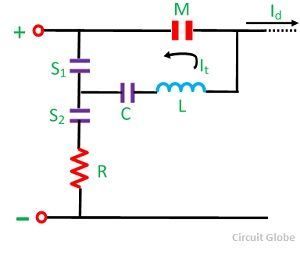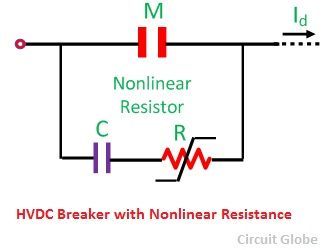The HVDC circuit breaker is a switching device that interrupts the flow of abnormal direct current in the circuit. When the fault occurs in the system, the mechanical contacts of the circuit breaker are pulled apart and thus their circuit is open. In HVDC circuit breaker, circuit breaking is difficult because the current flow through it is unidirectional and there is no zero current.
The main application of the HVDC circuit breaker is to interrupt the high voltage direct current flows in the network. AC circuit breaker easily interrupts the arc at natural current zero in the AC wave. At zero current, the energy to be interrupted is also zero. The contact gap has to recover the dielectric strength to withstand natural transient recovery voltage.
With DC circuit breakers, the problem is more complex as the DC waveform does not have natural current zeros. Forced arc interruption would produce high transient recovery voltage and restrike without arc interruption and ultimate destruction of the breaker contacts. In designing of HVDC circuit breakers, there are three main problems to be overcome. These problems are
- Creation of artificial current zero.
- Prevention of restrikes arc.
- Dissipation of stored energy.
The artificial current zero principles are used in HVDC circuit breakers for arc extinction. By introducing a parallel L-C circuit, the arc current is subjected to oscillations. These oscillations are severe and have several artificial current zeros. The breaker extinguishes the arc at one of the artificial current zeros. The crest current of the oscillation must be greater than the direct current to be interrupted.
A series resonant circuit with L and C is connected across the main contact M of a conventional DC circuit breaker through an auxiliary contact S1, and resistor R is connected through contact S2. Under normal operating conditions, main contact M and charging contact S2 remain closed, and the capacitor C is charged to line voltage through the high resistance R. Contact S1 is open and has line voltage across it.
 For interrupting main circuit current Id, the operating mechanism open contact S2 and closes contact S1. This indicates discharge of capacitor C through inductance L, main contact M and auxiliary contact S1 setting up an oscillatory current shown in the figure below. Thus, artificial current zeros are created, and the circuit breaker main contact M is opened at a current zero. After that, contact S1 is opened, and contact S2 is closed.
For interrupting main circuit current Id, the operating mechanism open contact S2 and closes contact S1. This indicates discharge of capacitor C through inductance L, main contact M and auxiliary contact S1 setting up an oscillatory current shown in the figure below. Thus, artificial current zeros are created, and the circuit breaker main contact M is opened at a current zero. After that, contact S1 is opened, and contact S2 is closed.
 Another way of interrupting the main direct current is by its diversion to the capacitor so that the magnitude of current to be interrupted by the circuit breakers becomes smaller. This is shown in the figure below. The capacitor C is initially uncharged.
Another way of interrupting the main direct current is by its diversion to the capacitor so that the magnitude of current to be interrupted by the circuit breakers becomes smaller. This is shown in the figure below. The capacitor C is initially uncharged.
When the main contact M opens, the main circuit current is diverted to the capacitor C. Thus, the current to be interrupted by the main contacts M becomes smaller. The nonlinear resistor R absorbs energy without greatly adding to the voltage across the main contact M.
 The rate of rising of the recovery voltage across M is expressed as
The rate of rising of the recovery voltage across M is expressed as
 The problem of prevention of restrikes is very intense in oscillating current DC circuit breakers where the time in which the current is chopped is very small. Thus, the steep surge of the restriking voltage across breaker terminals is produced, and the circuit breaker must be capable of withstanding this voltage.
The problem of prevention of restrikes is very intense in oscillating current DC circuit breakers where the time in which the current is chopped is very small. Thus, the steep surge of the restriking voltage across breaker terminals is produced, and the circuit breaker must be capable of withstanding this voltage.

This was more than helpful thank you so much